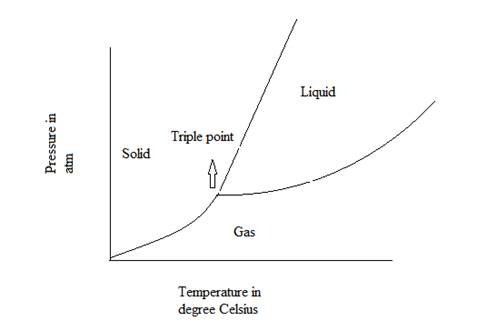
Concept explainers
Interpretation:
The temperature and pressure should be determined when the substance is at its triple point.

Concept introduction:
When energy or heat is gain or lost by any matter, the matter changes its state to form a
State of matter is classified as:
- Solid
- Liquid
- Gas
A graphical diagram which represents the physical states of a substance under different values of temperature and pressure is known as phase diagram.
The general representation of phase diagram is:

Triple point of a substance is defined as the point at which solid, liquid and gas phase or state of that substance coexist in the equilibrium.
Answer to Problem 11STP
The value of temperature and pressure of a substance at triple point is 13
Explanation of Solution
The three curves of solid, liquid and gas phase when intersects at a point is known as triple point.
The given graph is:

A line should be drawn parallel to y- axis from triple point towards x-axis. Now, the point at which line intercept the x-axis gives the value of temperature with respect to triple point.
Graph can be redrawn as:

Therefore,
On x-axis, value of pressure is 5 atm.
On y-axis, value of temperature is
Hence, the value of temperature and pressure of a substance at triple point is
Chapter 21 Solutions
Chemistry: Matter and Change
Additional Science Textbook Solutions
Organic Chemistry (8th Edition)
Chemistry: Structure and Properties (2nd Edition)
Organic Chemistry (9th Edition)
Chemistry: The Central Science (14th Edition)
Chemistry: A Molecular Approach (4th Edition)
Chemistry: The Central Science (13th Edition)
 ChemistryChemistryISBN:9781305957404Author:Steven S. Zumdahl, Susan A. Zumdahl, Donald J. DeCostePublisher:Cengage Learning
ChemistryChemistryISBN:9781305957404Author:Steven S. Zumdahl, Susan A. Zumdahl, Donald J. DeCostePublisher:Cengage Learning ChemistryChemistryISBN:9781259911156Author:Raymond Chang Dr., Jason Overby ProfessorPublisher:McGraw-Hill Education
ChemistryChemistryISBN:9781259911156Author:Raymond Chang Dr., Jason Overby ProfessorPublisher:McGraw-Hill Education Principles of Instrumental AnalysisChemistryISBN:9781305577213Author:Douglas A. Skoog, F. James Holler, Stanley R. CrouchPublisher:Cengage Learning
Principles of Instrumental AnalysisChemistryISBN:9781305577213Author:Douglas A. Skoog, F. James Holler, Stanley R. CrouchPublisher:Cengage Learning Organic ChemistryChemistryISBN:9780078021558Author:Janice Gorzynski Smith Dr.Publisher:McGraw-Hill Education
Organic ChemistryChemistryISBN:9780078021558Author:Janice Gorzynski Smith Dr.Publisher:McGraw-Hill Education Chemistry: Principles and ReactionsChemistryISBN:9781305079373Author:William L. Masterton, Cecile N. HurleyPublisher:Cengage Learning
Chemistry: Principles and ReactionsChemistryISBN:9781305079373Author:William L. Masterton, Cecile N. HurleyPublisher:Cengage Learning Elementary Principles of Chemical Processes, Bind...ChemistryISBN:9781118431221Author:Richard M. Felder, Ronald W. Rousseau, Lisa G. BullardPublisher:WILEY
Elementary Principles of Chemical Processes, Bind...ChemistryISBN:9781118431221Author:Richard M. Felder, Ronald W. Rousseau, Lisa G. BullardPublisher:WILEY





